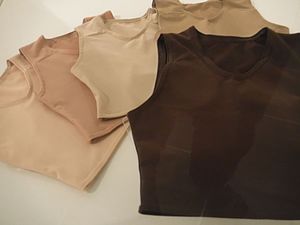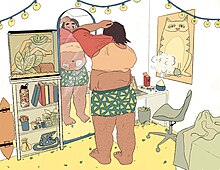Breast binding
 From Wikipedia - Reading time: 14 min
From Wikipedia - Reading time: 14 min

Breast binding, also known as chest binding, is the flattening and hiding of breasts with constrictive materials such as cloth strips or purpose-built undergarments. Binders may also be used as alternatives to bras or for reasons of propriety.
People who bind include women, trans men, non-binary people, and cisgender men with gynecomastia.
History
[edit]Breast binding has been used in many historical contexts. Different time periods of history have had differing viewpoints on the female form, including the widespread use of corsets throughout western European history up to the Victorian era.[1]

During the era of China's imperial dynasties, revealing the curves of a woman's breast was considered lewd and breasts were often bound with a moxiong or a dudou. The use of the garment was particularly popular during the Tang and Song dynasties.[2][3] Breast binding became an exclusive aesthetic practice for women continuing until the 1930s, with more prevalence among upper-class women.[4] The long-standing custom resulted from a culture that "believed large breasts were symbols of lasciviousness."[5]

Korean women wearing the traditional hanbok concealed the female body by binding their breasts tightly with a cloth band.[6][7]
In Japan, the traditional kimono flattens the appearance of the breasts, with breasts bound and flattened with an obi,[8] and a datemaki belt wrapped around the torso from the chest to the waist.[9] A sarashi is used by Japanese women to flatten their breasts.[citation needed]
In Africa, adolescent Wodaabe girls had their breasts tightly bound to induce sagging, minimize sexual desirability, and improve their ability to breastfeed.[9] In cultures where the breasts of pubescent girls are ironed to suppress their development, wealthier classes often choose to use an elastic belt to compress and flatten the breasts.[10]
Until the early 20th century, many Catholic nuns bound their breasts under their habit to deflect the attention of male clergy and diminish sexual desire in men.[1][9]
Breast binding was one of the punishments inflicted upon the women inmates confined in Ireland's Magdalene asylums.[11]
Post-WWI women office workers modified their physique with bound breasts to reduce and conceal the female form, thereby minimizing sexual curiosity from males.[12]
In the 1920s, a flat-chested silhouette became the ideal look among women, with breasts bound against the chest wall with binders.[13] To present a boyish form, flappers bound their breasts.[13]
Wearing a corset was one way that the size of breasts could be reduced.[1]
Motivation
[edit]This section needs additional citations for verification. (November 2022) |

There are many reasons for binding breasts:[14]
- For accelerated recovery by reducing movement after an injury or surgery.
- For lactation suppression.[15]
- For concealment of breasts or breast development.
- For beauty and aesthetics.
- For male impersonation, cosplay, crossplay, and other forms of costuming.
- For a masculine clothed appearance, to assist with passing as male.
- For transgender men, including non-binary people, it alleviates gender dysphoria by altering the appearance of the chest[16] and creates gender euphoria; and as a substitute for, or prior to chest masculinization surgery.
Women who have developed larger breasts from hormone replacement therapy or breast augmentation surgery may choose to bind.
Some adolescents begin to bind their breasts as they enter puberty. One case study has described an adolescent girl binding as a symptom of her body dysmorphic disorder,[17] but this is not the most common reason that individuals bind their breasts.
Transmasc and non-binary people
[edit]
Transgender men and non-binary people may bind their breasts as an alternative to or while waiting for top surgery.[18] The appearance of a flat chest may minimize gender dysphoria[19] and cause gender euphoria.[20]
Many people who bind for gender-affirming purposes are unwilling to seek medical attention due to a perceived lack of knowledge from healthcare professionals and continue binding since they believe the benefits outweigh the risks.[21] In case of health concerns, they tend to seek help from healthcare professionals they perceive as trans-friendly and who will not stigmatize their binding practice.[22]
Gynecomastia
[edit]Cisgender men afflicted with gynecomastia may find cause to bind as a means to control the appearance of breasts, during the wait before surgery or as an alternative to surgery.[14] Some apparel companies (such as Underworks) make compression shirts for cisgender men that provide the same result as a breast binder.[23]
Methods
[edit]Modern binders or binding bras are purpose-built undergarments often made of spandex or other synthetic fibre. These can be more expensive than other breast-binding options and are not widely stocked, but they are generally considered less dangerous than alternatives.[citation needed] Other common binding materials include cloth strips or non-elastic bandages.
Elastic bandages (such as "Ace" brand bandages) are considered unsafe to use. Duct tape has also been used to bind breasts, but it is dangerous and should be avoided. It is safer to use a binder from a reputable company or a high impact sports bra.[24]
Tops layered from tight-fitting to loose can also be used to hide breasts.
Complications
[edit]Breast binding is known to create a number of health risks, including difficulty breathing, backache, skin rashes, and deformity of the ribs.[1]
To minimise complications, some limit their binding use for no longer than eight hours.[21] Binding for extended periods of time can lead to rashes or yeast infections under the breasts,[25][26] back or chest pain, shortness of breath, overheating, or, rarely, fractured ribs.[21] Additionally, some unconventional binding materials, such as duct tape, body tape, binding tape or athletic bandages, are known to increase an individual's risk for negative health outcomes such as shortness of breath, musculoskeletal damage, and skin damage.[27] Unsafe binding may lead to permanent deformation of the breasts,[28] scarring, and lung constriction,[29] and long-term binding may adversely affect the outcome of a future mastectomy.[30]
See also
[edit]References
[edit]- ^ a b c d Smith, Merril D., ed. (2014). Cultural Encyclopedia of the Breast. Lanham, Maryland: Rowman & Littlefield. pp. 45–46. ISBN 978-0759123311.
- ^ "The ancient art of women's underwear". China Daily. March 4, 2011. Retrieved 5 November 2022.
- ^ "The little red look". The Economist. April 16, 2016. Archived from the original on 5 November 2022. Retrieved 5 November 2022.
- ^ Lei, Jun (Spring 2015). ""Natural" Curves: Breast-Binding and Changing Aesthetics of the Female Body in China of the Early Twentieth Century". Modern Chinese Literature and Culture. 27 (1): 163–223. ISSN 1520-9857.
- ^ Jiao, Lin (2017). Nation, Fashion and Women's Everyday Lives: Breast-binding in China, 1910s-1970s (PDF) (PhD thesis). SOAS University of London. doi:10.25501/SOAS.00024390.
- ^ Shin, Gi-Wook; Robinson, Michael, eds. (1999). Colonial Modernity in Korea. Cambridge, Massachusetts: Harvard University Asia Center. p. 421. ISBN 978-0674005945.
- ^ Kim, Julie Ju-Youn (2014). "Rendering the Body Present: Unwrapping the Hanbok and Villa of Veils". Academia.edu. p. 13.
- ^ Tewari, Nita; Alvarez, Alvin, eds. (2009). Asian American Psychology: Current Perspectives. New York: Psychology Press. p. 197. ISBN 978-1841697697.
- ^ a b c Kenny, Erin; Nichols, Elizabeth Gackstetter (2017). Beauty around the World: A Cultural Encyclopedia. Santa Barbara, California: ABC-CLIO. pp. 46–48. ISBN 978-1610699440.
- ^ "Breast Ironing Fact Sheet". Africa Health Organisation. March 22, 2019. Retrieved 10 November 2022.
- ^ Gibbons, Fiachra (6 February 2003). "In God's Name". The Guardian. Retrieved 4 November 2022.
- ^ Yellis, Kenneth A. (Spring 1969). "Prosperity's Child: Some Thoughts on the Flapper". American Quarterly. 21 (1): 54. doi:10.2307/2710772. ISSN 0003-0678. JSTOR 2710772.
- ^ a b Farrell-Beck, Jane; Gau, Colleen (2002). Uplift: The Bra in America. Philadelphia, Pennsylvania: University of Pennsylvania Press. pp. 41, 49. ISBN 0812236432.
- ^ a b Haghighi, Anna Smith (June 29, 2022). "What is binding, and how can I do it safely?". Medical News Today. Retrieved April 16, 2023.
- ^ Swift, Kathy; Janke, Jill (May–June 2003). "Breast Binding . . . Is It All That It's Wrapped Up To Be?". Journal of Obstetric, Gynecologic, & Neonatal Nursing. 32 (3): 332–339. doi:10.1177/0884217503253531. ISSN 0884-2175. PMID 12774875.
- ^ Countryman, Betty Ann. "Breast care in the early puerperium." Journal of Obstetric, Gynecologic, & Neonatal Nursing 2.5 (1973): 36–40
- ^ Horowitz K, Gorfinkle K, Lewis O, Phillips KA (December 2002). "Body dysmorphic disorder in an adolescent girl". J Am Acad Child Adolesc Psychiatry. 41 (12): 1503–9. doi:10.1097/00004583-200212000-00023. PMC 1613829. PMID 12447038.
- ^ Bashforth, Emily (December 30, 2022). "How to bind your chest safely". LGBTQ Nation. Retrieved April 16, 2023.
- ^ Julian, Jamie M.; Salvetti, Bianca; Held, Jordan I.; Murray, Paula M.; Lara-Rojas, Lucas; Olson-Kennedy, Johanna (2021). "The Impact of Chest Binding in Transgender and Gender Diverse Youth and Young Adults". The Journal of Adolescent Health. 68 (6): 1129–1134. doi:10.1016/j.jadohealth.2020.09.029. ISSN 1879-1972. PMID 33121901. S2CID 226205016.
- ^ Beischel, Will J.; Gauvin, Stéphanie E. M.; van Anders, Sari M. (2022). ""A little shiny gender breakthrough": Community understandings of gender euphoria". International Journal of Transgender Health. 23 (3): 274–294. doi:10.1080/26895269.2021.1915223. ISSN 2689-5269. PMC 9255216. PMID 35799953.
- ^ a b c Tsjeng, Zing (September 28, 2016). "Inside the Landmark, Long Overdue Study on Chest Binding". Vice News. Retrieved 20 March 2023.
- ^ Jarrett, Brooke A.; Corbet, Alexandra L.; Gardner, Ivy H.; Peitzmeier, Sarah M. (14 Dec 2018). "Chest Binding and Care Seeking Among Transmasculine Adults: A Cross-Sectional Study". Transgender Health. 3 (1). Mary Ann Liebert, Inc., publishers: 170–178. doi:10.1089/trgh.2018.0017. PMC 6298447. PMID 30564633.
- ^ Jones, Eve (June 4, 2022). "Best chest binder". Fox31 Denver. Retrieved April 16, 2023.
- ^ "Trans Tape for Chest Binding: Insights on How To Use Tape". GenderGP. June 22, 2020.
- ^ Feldman, JL; Goldberg, J (2006). "Transgender primary medical care: Suggested guidelines for clinicians in British Columbia". Vancouver Coastal Health. Retrieved 15 June 2014.
- ^ Erickson-Schroth, Laura (2014). Trans Bodies, Trans Selves: A Resource for the Transgender Community. Oxford University Press. p. 134. ISBN 9780199325351.
- ^ "Chest Binding: A Physician's Guide". PRIDEinPractice. 6 April 2019. Retrieved 1 October 2020.
- ^ "Binding FAQ" (PDF). University of Michigan Health System. Archived from the original (PDF) on 6 September 2012.
- ^ Dutton, Lauren; Koenig, Karel; Fennie, Kristopher (2008-08-01). "Gynecologic care of the female-to-male transgender man". Journal of Midwifery & Women's Health. 53 (4): 331–337. doi:10.1016/j.jmwh.2008.02.003. ISSN 1542-2011. PMC 4902153. PMID 18586186.
- ^ Makadon, Harvey J.; Mayer, Kenneth H.; Potter, Jennifer; Goldhammer, Hilary (2015). The Fenway Guide to Lesbian, Gay, Bisexual and Transgender Health. ACP Press. p. 409. ISBN 9781934465783.
Further reading
[edit]- Jiao, Lin (February 2021). "Reconciling Femininities and Female Masculinities: Women's Premarital Experiences of Breast-Binding in the Maoist Era". Modern China. 48 (2): 321–352. doi:10.1177/0097700421992314. ISSN 0097-7004. S2CID 233952210.
- Lucas, Julian (December 15, 2021). "The Two Mountains Weighing Down My Chest – An Interview with Film Director Viv Li". The Pomonan. Archived from the original on November 10, 2022. Retrieved November 10, 2022.
- Kelly, Simone (September 4, 2024). "What is Chest Binding?". Transform Transwear.
External links
[edit] Media related to Binders (clothing) at Wikimedia Commons
Media related to Binders (clothing) at Wikimedia Commons
 KSF
KSF